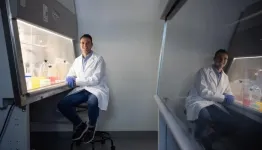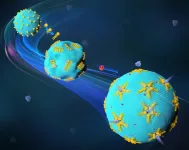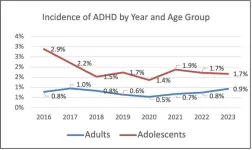Manure management in China cuts river antibiotic pollution but raises groundwater contamination risks
2025-01-13
(Press-News.org)
A recent study published in Environmental Science and Ecotechnology reveals significant changes in antibiotic pollution patterns in China’s water systems over the past decade, driven by evolving manure management practices. Conducted by researchers from China Agricultural University and Wageningen University, the study developed the MARINA-Antibiotics (China-1.0) model to track antibiotic flows from livestock manure into rivers and groundwater across 395 sub-basins between 2010 and 2020.
The study found a 59% decrease in antibiotic pollution in rivers, primarily due to improved manure recycling and reduced direct manure discharge into waterways. However, this improvement came with an unintended consequence: antibiotic leaching into groundwater increased by 15%, largely as a result of expanded manure use as fertilizer on farmland.
Key findings indicate that fluoroquinolones remain the dominant antibiotics in rivers, primarily sourced from pig, cattle, and chicken manure, while sulfonamides account for over 90% of antibiotics in groundwater, mainly originating from pig and sheep manure.
The study emphasizes the success of existing agricultural policies in mitigating river pollution but highlights the urgent need for strategies that address the growing risks of groundwater contamination. Researchers call for integrated manure management policies that balance both river and groundwater protection.
This research provides valuable insights for policymakers and serves as a model for other countries tackling antibiotic pollution from intensive livestock farming.
END
ELSE PRESS RELEASES FROM THIS DATE:
2025-01-13
SAN ANTONIO, Jan. 13, 2025 – With cancer still rising in the U.S. Latino population, leaders at The University of Texas Health Science Center at San Antonio (UT Health San Antonio) and national cancer experts have published an online book with innovative recommendations to reduce Latino cancer.
The book, “Advancing the Science of Cancer in Latinos: 2024 Conference Proceedings,” highlights results of the same-named conference that brought 300 researchers, advocates and survivors to San Antonio in February 2024.
A follow-up conference is planned for Feb. 18-20, 2026, in San Antonio.
Included ...
2025-01-13
UNIVERSITY PARK, Pa. — The invasive emerald ash borer, according to the U.S. Department of Agriculture, was first found in the United States in southeast Michigan in 2002. In the decades since, the wood-boring beetle has spread east and west across the U.S. and Canada, killing tens of millions of ash trees, causing one of the costliest forest insect invasions to date. More than 90% of all ash infested by the insect native to Asia eventually die, threatening to make the tree species functionally extinct in North America. In response, researchers at Penn State are working with the U.S. Forest Service and other partners to identify and develop ...
2025-01-13
CRISPR is a powerful gene-editing tool that holds enormous potential for treating genetic diseases by allowing scientists to cut, replace, or delete mutations in DNA. It can also modify gene expression, temporarily amplifying or diminishing its effects.
Yet, despite its promise, applying CRISPR (which is a reagent, or a substance that facilitates a reaction) in patients presents significant challenges.
“CRISPR is difficult to control when you want to do gene editing in vivo, or directly in the patient,” says Tomas Gonzalez-Fernandez, an assistant professor of bioengineering in Lehigh University’s P.C. Rossin College of Engineering ...
2025-01-13
Scientists at the University of Stuttgart have succeeded in controlling the structure and function of biological membranes with the help of "DNA origami". The system they developed may facilitate the transportation of large therapeutic loads into cells. This opens up a new way for the targeted administration of medication and other therapeutic interventions. Thus, a very valuable instrument can be added to the toolbox of synthetic biology. Prof. Laura Na Liu and her team published their findings in the journal Nature Materials (DOI: 10.1038/s41563-024-02075-9).
The ...
2025-01-13
Lap Fai (Craig) Yu, Associate Professor, Computer Science, College of Engineering and Computing, and Joel Martin, Associate Professor, Kinesiology, College of Education and Human Development, received funding for the project: “EAGER: TaskDCL: Adapting Mixed Reality Training Programs to Real-World Scenes to enhance Human-AI Teaming in Emergency Responses.”
This EArly-concept Grant for Exploratory Research (EAGER) project funds research that intends to speed up the development of mixed reality and artificial intelligence (AI) technologies to help ...
2025-01-13
HOUSTON and BEAUMONT, TEXAS ― In an effort to improve public health and reduce cancer risk in East Texas, leaders in Beaumont are working with The University of Texas MD Anderson Cancer Center to launch Be Well™ Beaumont through a newly announced $10 million gift from ExxonMobil. Community members, collaborators and representatives from MD Anderson kicked off the 10-year initiative today in Beaumont.
Be Well Beaumont aims to promote wellness and to lower cancer risk among community members by providing them with cancer prevention education and tools. ...
2025-01-13
The cause of rare diseases is increasingly being detected through genome sequencing, which involves reading the entire human DNA by first breaking it into small pieces—short reads. Christian Gilissen, Lisenka Vissers, and colleagues found that a new technique using long reads is even more effective at detecting complex causes. They report that eighty to ninety percent of cases were detectable, as stated in the American Journal of Human Genetics.
Rare diseases are typically due to genetic causes. These causes are more and ...
2025-01-13
One supermassive black hole has kept astronomers glued to their scopes for the last several years. First came a surprise disappearance, and now, a precarious spinning act.
The black hole in question is 1ES 1927+654, which is about as massive as a million suns and sits in a galaxy that is 100 million light-years away. In 2018, astronomers at MIT and elsewhere observed that the black hole’s corona — a cloud of whirling, white-hot plasma — suddenly disappeared, before reassembling months later. The brief though dramatic shut-off was a first in black hole astronomy.
Members of the MIT team have now caught the same black hole exhibiting ...
2025-01-13
New research identifies differing trends in attention-deficit/hyperactivity disorder (ADHD) diagnoses among adolescents and adults, including an increase among adults from 2020 to 2023. The study, published in the American Psychiatric Association Journal Psychiatric Research and Clinical Practice, found a significant downward trends in ADHD incidence among adults from 2016 to 2020 and adolescents from 2016 to 2018. The ADHD incidence rate remained stable for adolescents in subsequent years.
ADHD is a neurodevelopmental disorder involving inattention and/or hyperactivity and impulsivity that interferes with a person’s functioning and ability ...
2025-01-13
A new study shows that the risk of developing dementia anytime after age 55 among Americans is 42%, more than double the risk reported by older studies.
That dementia risk translates into an estimated half-million cases this year, rising to 1 million new cases a year by 2060, according to the new work. Dementia involves progressive declines in memory, concentration, and judgment. The increasing number of cases is directly tied to the aging of the U.S. population. Beyond aging, a high risk of dementia is linked to genetic factors, as well as high rates of hypertension and diabetes, obesity, unhealthy diets, ...
LAST 30 PRESS RELEASES:
[Press-News.org] Manure management in China cuts river antibiotic pollution but raises groundwater contamination risks





